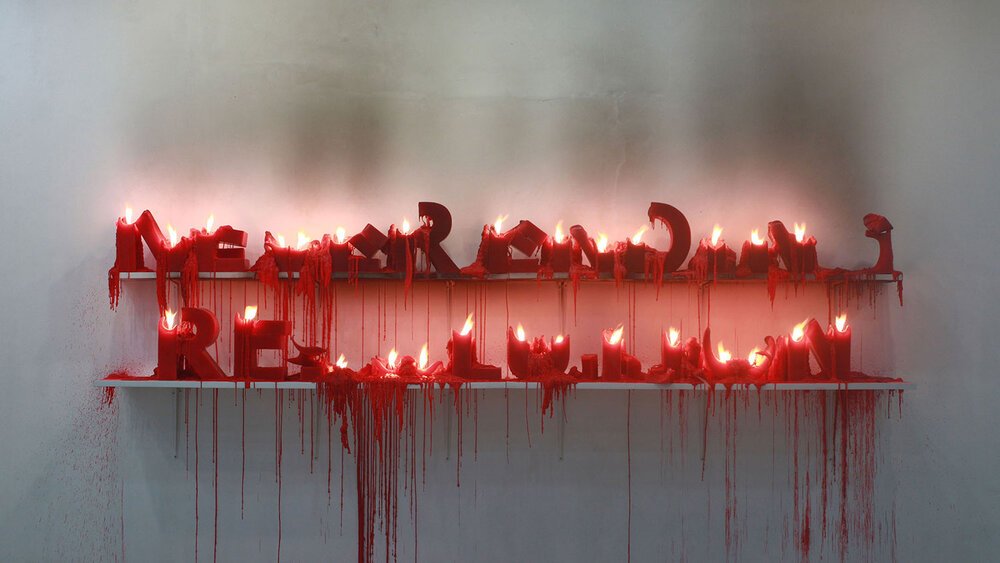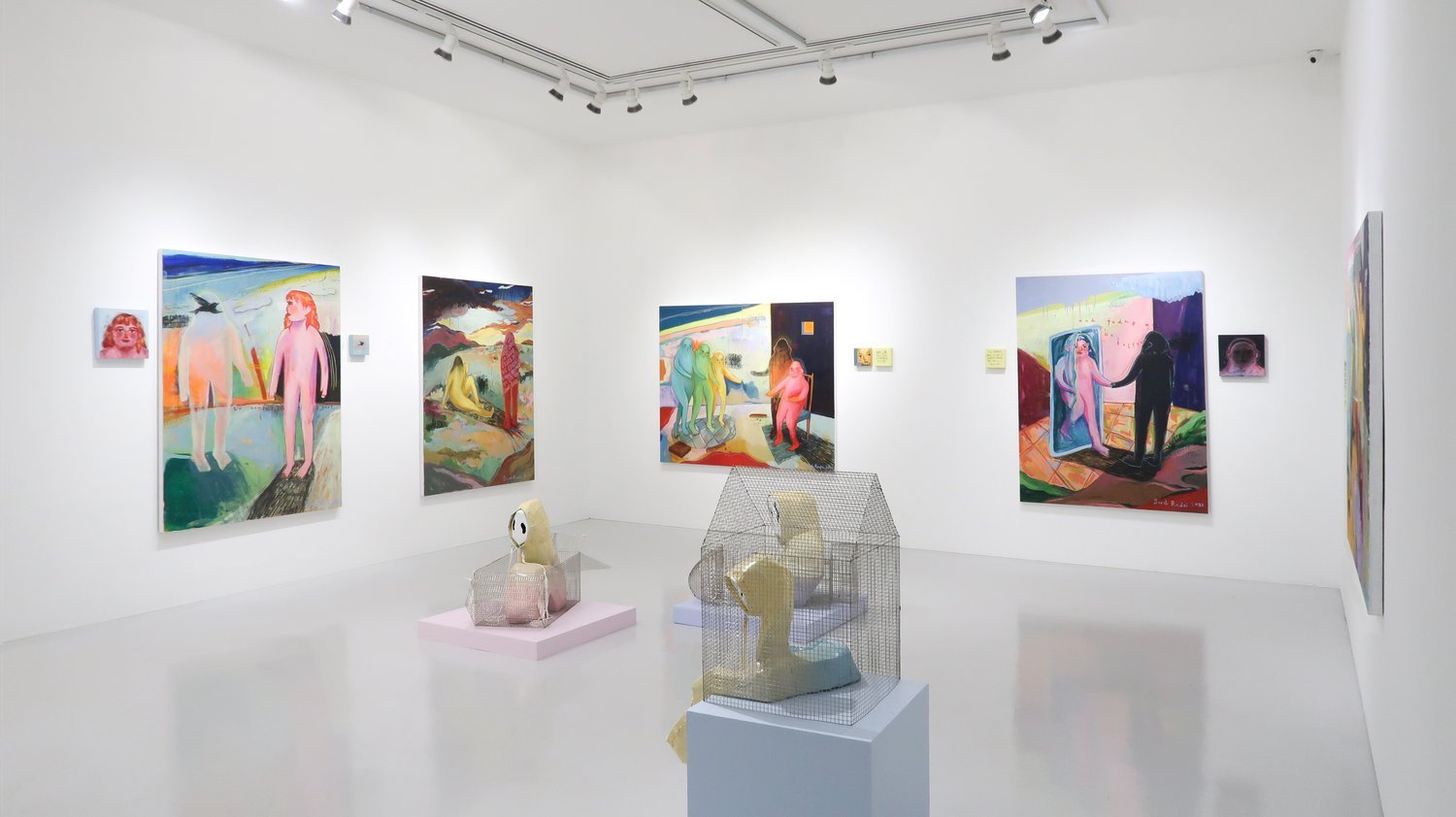Review of 'Work-in-Progress' at SEED The Art Space
Unpacking development in Southeast Asia through video art
By Ho See Wah
Stepping into ‘Work-in-Progress’, there is a sense of different streams of time trickling along in the intimate space. This impression is concocted through the many video screens present, where scenes are gently travelling through the passage of time, each at its own pace.
‘Work-in-Progress’ (2021) at SEED The Art Space, exhibition installation view. Photo by Lourdes Samson, image courtesy of SEED.
The exhibition at SEED The Art Space explores the notion of progress across the region through the video works of seven Southeast Asian artists and collectives: Debbie Ding, Charles Lim, Perception3 (Singapore), Christina Quisumbing Ramilo, Martha Atienza (The Philippines), Lim Sokchanlina (Cambodia) and Tromarama (Indonesia). Progress in contemporary times is often associated with ideas such as urbanisation, industrialisation and globalisation. Yet, these “-isations” often hide away their unsavoury aspects in favour of the cleaner facade of an ubiquitously modernised world. On a curator’s tour with SEED’s co-founder Lourdes Samson that I attended, she says, “The artists do not necessarily engage with the concept of progress or development consciously, but the works reveal much in the underlying conditions of the images that they present and at times, how the work was produced.” In this manner, we catch a glimpse of the myriad of ways that progress and its afflictions manifest in different landscapes.
As another aspect of contemporary progress is the advancement of digital technologies, there is a self-reflexiveness in bringing this and the medium of video art together. “In the 1990s, the influx of commercially available equipment like video cameras, recorders and home computers allowed artists in the region to experiment with the medium”, says Samson. “It becomes a good starting point from which we can look at the idea of progress in the region.” Beyond its conceptual apparatus, video art also allows for a direct and dynamic way of engaging with its subject’s temporal and spatial propensities. Samson adds, “This medium has an immersive quality as an art form, and it is able to expand on the poetry of images through the addition of movement and time.” This perspective on video art plays out in the selection of works where there is a heightened sensitivity on how the rhythms of the works’ focus are captured.
“This perspective on video art plays out in the selection of works where there is a heightened sensitivity on how the rhythms of the works’ focus are captured.”
Lim, Sokchanlina, ‘Wrapped Future II’, 2019, single-channel video and sound, 14min 43sec. Image courtesy of the artist.
The well-curated display did not overload with lengthy, narrative-driven artworks that require the rapt attention of their observers from start to end. Rather, there are accessible entry points into the works at each moment, allowing me to weave in and out of each piece at my own pace. Take for instance the work of Cambodian artist Lim Sokchanlina, which is the first artwork one encounters in the space. ‘Wrapped Future II’ (2019) features a piece of metal construction hoarding placed in various locations around the Cambodian countryside. It finds itself in the ocean, a lily pond, a burned forest patch and more. At times, the scenes are so still that one could almost mistake it for a photograph, if not for the subtle flow of water or the minute stirring of leaves. I am lured into a sense of peace and dreaminess by the lyrical landscapes and their enchanting colours. However, as the imagery slides past each location, I inevitably noticed how out of place the hoardings actually are in each scenario, and there is an odd sense of disturbance. While a hoarding usually signals transformation and new developments, Sokchanlina skillfully transforms it into an object for contemplation through defamiliarisation by presenting it in an unexpected manner so as to spurn new meaning. This is particularly poignant in light of the rapidly urbanising Phnom Penh, where cultures, histories and ecologies become ghostly spectres in favour of development. As the metal sheet moves from site to site, we are made to imagine what future we will find for Cambodia behind this hoarding.
Charles Lim, ‘Sea State 9: Proclamation (Pour)’, 2017, single-channel HD video (on loop) with output to high-luminosity seamless monitor, 2min 30sec (Pour). Image courtesy of the artist.
In contrast to the stillness of Sokchanlina’s work is Singaporean artist Charles Lim’s ‘Sea State 9: Proclamation’ (2017). In terms of movement, this three-channel installation is the busiest within the exhibition. The work touches on Singapore’s incessant drive to expand its territory through reclamation, and each screen demonstrates the specific techniques, ‘Drag’, ‘Drop’ and ‘Pour’, used to do so. Captured on a drone, the videos show the details of these processes in crisp clarity, and it is mesmerising to see the bird-eye view of a sizable barge cutting through the sea, and the close-up of a machinery constantly spewing sand into the waters. By showing us differing perspectives of reclamation through scaling in and out, Lim impresses upon us the tremendous technical and operational requirements necessary for this endeavour. At the same time, the unremitting flow of sand on screen mirrors the relentless bid for creating and claiming new territories. Interestingly, without the president’s proclamation, these new lands are officially still a part of the sea. The title of the work further complicates the idea of “nation-building” through the absurdity of this null island, and questions both the physical and intangible realities of Singapore’s continual march toward progress.
Martha Atienza, ‘Newfoundland N 47° 9' 35.424”, W 49° 55' 18.75”’, 2015, single-channel video, 48min loop. Image courtesy of the artist.
Placed strategically next to Lim’s work is Philippine artist Martha Atienza’s ‘Newfoundland N 47° 9' 35.424”, W 49° 55' 18.75”’ (2015). When watching them side by side, I see that they simultaneously reveal the role of water bodies in meaning-making and world-building beyond their materiality. Atienza brings the Atlantic Ocean into the space through a grand shot of the waters captured in one continuous take. Intentionally presented in slow motion, a sense of awe is readily instilled as the viewer’s attention is drawn toward the raw prowess of the ocean, where the waters persistently swell and crash on a monumental scale. The artwork finds its roots in the artist’s deep fascination with the Atlantic and its many depictions in art and literature during the 18th and 19th centuries. It is also a contemplation of her connection to oceanic bodies as she comes from a family of seafarers, such as a sea captain and a lighthouse watcher, as well as her own experiences of living on Bantayan Island. The work invites us to deliberate on the multitudinous connotations of this ocean, from its colonial past and its place in art and literature, to its role in environmentalism and global trade. Watching the ebb and flow of this ferocious force, I too am pushed and pulled along with the many histories and present circumstances it embodies.
Tromarama, ‘Neverending Resolution’, 2010, single-channel video documentation, 2min 49sec loop. Image courtesy of the artists.
“It is through this conscious and patient engagement that we may dissolve into the moving images, paving the way for the many propositions they contain.”
While all the works are in constant motion, with each flowing along at their own unique rhythm, the overall exhibition conjures up a mood of quiet introspection. Viewers are invited to take their time with the art on display, and cushions are offered for those wishing to watch the videos at length. Indeed, it is through this conscious and patient engagement that we may dissolve into the moving images, paving the way for the many propositions they contain.
‘Work-in-Progress’ on view from 30 January to 7 March 2021 at SEED The Art Space, Singapore.















